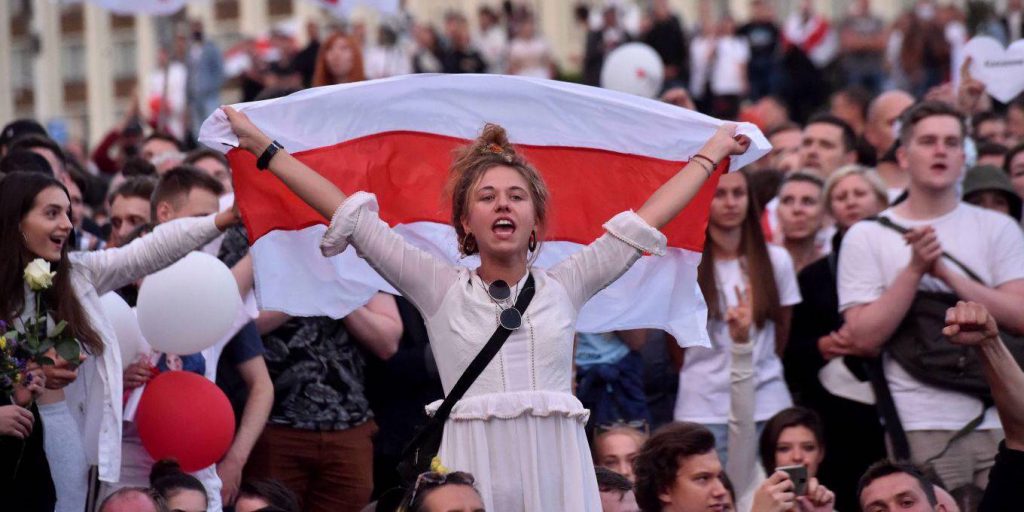Sharan Srinivas
Autocratic leaders often seek new ways to undermine the right to protest, because they know protesting can be an extraordinarily powerful force for political and social change. Over the past decade, protests have toppled autocrats, forced governments and corporations to recognise the climate emergency, given a voice to workers suffering under unfair economic systems, and urged reforms to address police brutality and structural racism.
As Peter Mutasa – president of the Zimbabwe Congress of Trade Unions, which has protested this year for better working conditions – has observed, protests are often the “only countervailing power and force” to repressive governments and the only way for marginalised people to gain access to public services. And even in contexts where they have not yet achieved their goals, protests have shaken entrenched power structures.
In Belarus, for example, peaceful protests led by women (with the active involvement of broad sections of Belarusian society, including artists and trade unionists) have continued since August’s rigged presidential election. In Thailand, protesters’ ongoing demonstrations for democratic reforms have highlighted a crucial debate about the monarchy’s constitutional role, which until recently was off-limits for public discussion. And protests in the wake of George Floyd’s murder in May made structural racism a central issue in the US presidential election campaign.
But governments are employing ever more sophisticated and aggressive tactics to curtail people’s ability to protest. This fundamental right is often threatened in four main ways.
First, governments are repurposing existing laws to limit protests and detain participants. In India, police have arrested protesters under sedition and anti-terrorism laws, while officials in Hong Kong have cracked down on protests by deploying public-order laws (ostensibly to prevent the spread of COVID-19). Other countries, including Algeria, Angola, Lebanon, and Thailand, have also used emergency anti-COVID measures to harass, intimidate, and jail protesters. Such arrests and crackdowns occur despite the recognition of the right to peaceful assembly in many of these countries’ constitutions, as well as international law.
Second, some governments – most recently in Belarus and Nigeria – have tried to quash protests violently. These governments not only disperse and detain protesters, but also torture and even kill them.
Third, governments have curtailed protesters’ ability to organise by ordering repeated Internet shutdowns. The #KeepItOn coalition, convened by the digital-rights group Access Now, recorded at least 65 Internet shutdowns during protests in 2019, including in Sudan, Iraq, Iran, Venezuela, Zimbabwe, Algeria, India, and Indonesia. The Belarusian government has also repeatedly shut down the Internet during this year’s protests.
Fourth, governments, non-state actors, and some media organisations have demonised and stigmatised protesters. US President Donald Trump, for example, has called peaceful protesters rioters, looters, thugs, and anarchists.
Another way to delegitimise protesters is to cast doubt on their motives by referring to them, without evidence, as ‘paid protesters,’ or by characterising pro-democracy demonstrators as ‘anti-national’ and environmental activists as ‘anti-development.’ Such narratives aim to diminish public support for protesters and justify government crackdowns.
Despite the threats posed by such tactics, there is hope. A growing number of individuals and organisations worldwide are working to safeguard the right to protest. Some groups – for example, the Right2Protest coalition in South Africa – operate non-stop telephone hotlines for those who intend to protest peacefully, providing information and advice on legal frameworks. When protesters are arrested, these groups connect them with lawyers who work to ensure that they are granted bail and, if necessary, defend them (often pro bono) at their trials.
Other groups specialise in legal challenges to official policies and practices that infringe on the right to protest. In Uganda, for example, a five-year litigation effort spearheaded by four civil-society organisations led to a major victory in March, with the Constitutional Court striking down part of a law allowing Ugandan police to prevent or stop public gatherings arbitrarily. In September, Colombian civil-society groups won a sweeping judgment in the country’s Supreme Court that called for police reform and a gag order preventing public officials from openly demonising peaceful protesters.
Ultimately, though, the best protection for protest movements and those who defend them is the opportunity for participants to be part of something larger than themselves. “Solidarity is the engine that keeps us going,” says Mutasa.
Everyone – not only lawyers and NGOs – can play a part in upholding the right to peaceful protest. Doctors and nurses can provide emergency first aid. Teachers can educate their students about the right to peaceful protest and why it matters. Telecom operators can disregard government orders to shut down the Internet during protests. Media professionals and citizen journalists can provide a powerful counter-narrative to those seeking to demonise protesters. And as individuals, we can all take to the streets or voice our dissent online.
Without such solidarity, the right to protest is always vulnerable. And where that right is not upheld, few other rights are safe.
The writer is Senior Program Officer at the Open Society Foundations’ Human Rights Initiative. ©Project Syndicate.
